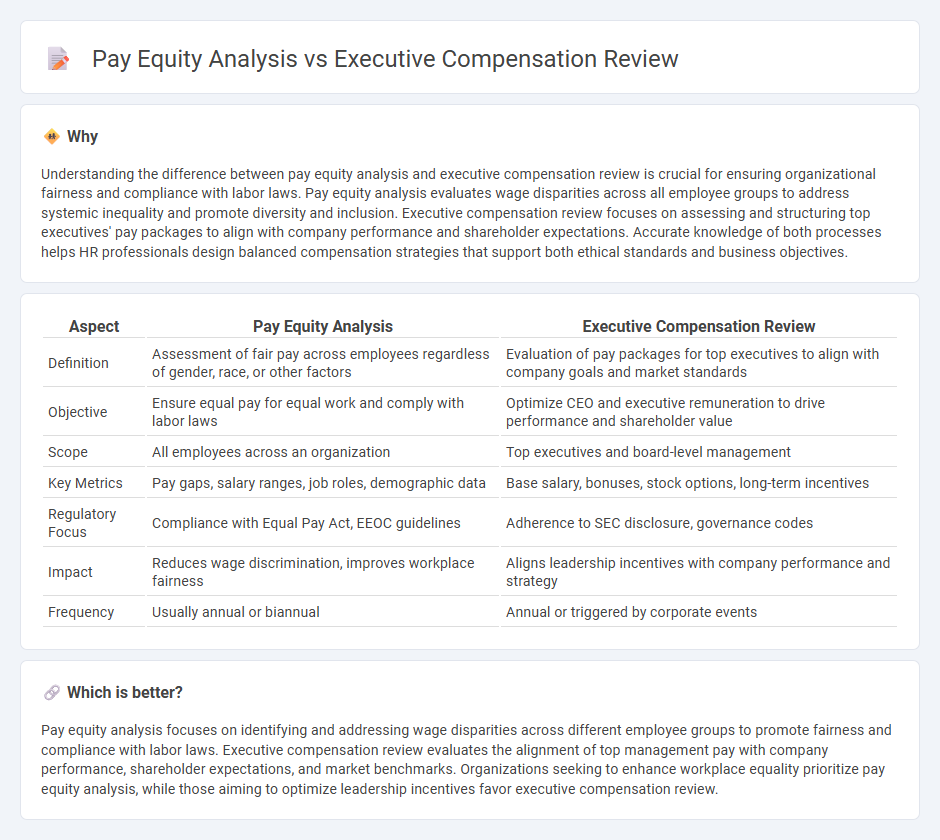
Pay equity analysis evaluates salary fairness across different employee groups to identify and address wage disparities, promoting diversity and inclusion within the workforce. Executive compensation review focuses on assessing the appropriateness and competitiveness of remuneration packages for top-level management, aligning leadership incentives with company performance and shareholder interests. Explore how integrating these approaches can enhance organizational fairness and strategic compensation planning.
Why it is important
Understanding the difference between pay equity analysis and executive compensation review is crucial for ensuring organizational fairness and compliance with labor laws. Pay equity analysis evaluates wage disparities across all employee groups to address systemic inequality and promote diversity and inclusion. Executive compensation review focuses on assessing and structuring top executives' pay packages to align with company performance and shareholder expectations. Accurate knowledge of both processes helps HR professionals design balanced compensation strategies that support both ethical standards and business objectives.
Comparison Table
| Aspect | Pay Equity Analysis | Executive Compensation Review |
|---|---|---|
| Definition | Assessment of fair pay across employees regardless of gender, race, or other factors | Evaluation of pay packages for top executives to align with company goals and market standards |
| Objective | Ensure equal pay for equal work and comply with labor laws | Optimize CEO and executive remuneration to drive performance and shareholder value |
| Scope | All employees across an organization | Top executives and board-level management |
| Key Metrics | Pay gaps, salary ranges, job roles, demographic data | Base salary, bonuses, stock options, long-term incentives |
| Regulatory Focus | Compliance with Equal Pay Act, EEOC guidelines | Adherence to SEC disclosure, governance codes |
| Impact | Reduces wage discrimination, improves workplace fairness | Aligns leadership incentives with company performance and strategy |
| Frequency | Usually annual or biannual | Annual or triggered by corporate events |
Which is better?
Pay equity analysis focuses on identifying and addressing wage disparities across different employee groups to promote fairness and compliance with labor laws. Executive compensation review evaluates the alignment of top management pay with company performance, shareholder expectations, and market benchmarks. Organizations seeking to enhance workplace equality prioritize pay equity analysis, while those aiming to optimize leadership incentives favor executive compensation review.
Connection
Pay equity analysis identifies wage disparities across employee groups ensuring fair compensation practices, while executive compensation review evaluates leadership pay alignment with company performance and market standards. Both processes aim to promote transparency and fairness in total remuneration, fostering trust and compliance with regulatory requirements. Integrating these analyses supports balanced pay structures that mitigate risks of inequity and enhance overall organizational integrity.
Key Terms
**Executive Compensation Review:**
Executive compensation review entails evaluating salary packages, bonuses, stock options, and other financial incentives for senior leaders to ensure alignment with company performance and industry benchmarks. This process involves analyzing competitive market data and internal pay structures to attract and retain top executive talent while promoting organizational goals. Explore how a comprehensive executive compensation review can drive strategic leadership effectiveness and shareholder value.
Long-Term Incentives
Long-term incentives (LTIs) play a crucial role in both executive compensation review and pay equity analysis by aligning leadership performance with shareholder value and ensuring fairness across employee groups. Executive compensation reviews assess the competitiveness and effectiveness of LTIs such as stock options and performance shares, while pay equity analyses evaluate whether similar roles receive equitable LTI opportunities regardless of gender or demographic differences. Explore our detailed insights to understand how to balance strategic incentivization with equitable reward practices.
Benchmarking
Executive compensation review involves benchmarking salary data against industry standards to ensure competitive and fair remuneration for top-level executives. Pay equity analysis examines compensation structures to identify and address disparities related to gender, race, or other protected characteristics within the organization. Explore more about how benchmarking drives both executive compensation reviews and pay equity analyses to create fair and competitive pay systems.
Source and External Links
Using Executive Compensation Data to Retain Talent - This article discusses how executive compensation data can help attract and retain leadership talent by aligning pay with industry standards and company goals.
What is an Executive Compensation Analysis? - An executive compensation analysis involves evaluating pay packages to ensure they are competitive and aligned with company objectives, helping attract and retain top executive talent.
Executive Compensation - This resource provides guidance on determining appropriate executive compensation for nonprofits, emphasizing the importance of a written policy and comparisons with peer organizations.
 dowidth.com
dowidth.com